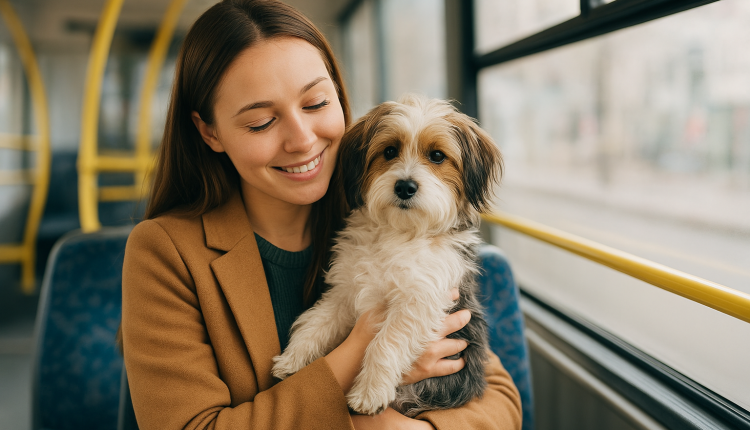Public Transport with Pets: Buses, Trains, and Subways — Rules and Preparation
Traveling with pets can be a heartwarming experience, but when public transport is involved, it often comes with a mix of challenges and rules that pet owners must understand. Whether you’re taking your dog on the subway, your cat on a long-distance train, or a small pet in a carrier on the bus, preparation and awareness make all the difference. Here’s a complete guide to help you and your furry (or feathered) companion travel comfortably and stress-free.
1. Understanding the Rules Before You Go
Every city and transportation company has its own regulations for animals on board. These rules often depend on the pet’s size, species, and behavior. In most cases, small pets are allowed if they are kept in a carrier, while large dogs may require special tickets or restrictions.
- Buses: Many bus systems only permit small pets in secure carriers that can fit on your lap or under the seat. Service animals, however, are almost always welcome, regardless of size.
- Trains: Policies tend to be more flexible on trains, especially on long-distance or intercity routes. Some rail services even allow dogs on leashes as long as they wear a muzzle. For example, in the UK, small pets travel for free, while larger dogs may need a ticket.
- Subways: Most metro systems have clear guidelines that require pets to be fully enclosed in a carrier or bag. During rush hours, pet travel may be discouraged or restricted due to crowding.
Always check the official website or contact customer service before departure. A five-minute check can save you from being denied boarding.
2. Choosing the Right Carrier
Your pet’s comfort starts with the right carrier. It should be well-ventilated, sturdy, and secure. For dogs and cats, soft-sided carriers are convenient for buses and subways, while rigid ones may be better for long train journeys.
Look for these features:
- A zippered opening for easy access.
- Mesh windows for airflow and visibility.
- A waterproof bottom to handle accidents.
- Enough space for the animal to stand, turn, and lie down comfortably.
If your pet is new to the carrier, let them get used to it at home first. Place treats, toys, or a blanket inside so they start associating it with safety and calmness.
3. Preparing Your Pet Emotionally
Public transport can be noisy, crowded, and filled with unfamiliar smells. To reduce anxiety:
- Take short practice trips by walking near bus stops or subway entrances.
- Play transport sounds at home to help your pet get used to the noise of engines and announcements.
- Reward calm behavior with treats or praise.
- Keep a favorite toy or blanket nearby for comfort.
For especially anxious animals, talk to your vet about calming sprays or pheromone collars. Avoid sedatives unless prescribed, as they can make pets disoriented in unfamiliar surroundings.
4. Timing and Planning Your Trip
Traveling outside of rush hours is one of the simplest ways to make the journey smoother. Fewer passengers mean less noise, less stress, and more space for you and your pet. If you’re planning a long train journey:
- Book window seats or corner spots where you can place the carrier securely.
- Avoid feeding your pet a large meal right before the trip.
- Bring water and a collapsible bowl for hydration.
- Carry waste bags and cleaning wipes in case of accidents.
Also, note that some trains and buses have specific pet-friendly cars or compartments—especially in Europe and Japan—so it’s worth checking in advance.
5. Etiquette During the Trip
Even if your pet is allowed, being considerate to other passengers is key. Not everyone is comfortable around animals, and allergies are common.
- Keep your pet quiet and close to you at all times.
- Do not allow them to occupy a seat unless the transport rules permit it.
- Keep your carrier clean and odor-free.
- Always respect designated no-pet zones.
If your dog is not in a carrier, ensure the leash is short and they stay calm. Avoid letting them interact with strangers without permission.
6. After the Journey
When you arrive, give your pet time to stretch, drink, and relieve themselves. Traveling in confined spaces can be exhausting even for small animals. Offer praise and affection — positive reinforcement will help them associate public transport with safety and comfort.
If you plan to use public transport frequently, repeat short rides until your pet becomes fully confident. Many pets learn to enjoy the motion and attention once they realize they’re safe.
7. Quick Checklist Before You Leave
- Check transport rules for pets.
- Prepare carrier and comfort items.
- Bring waste bags, wipes, and water.
- Attach an ID tag or microchip.
- Avoid traveling during peak hours.
- Carry proof of vaccinations (especially for intercity trips).
Final Thoughts
Public transport with pets is becoming more accessible worldwide, but it still demands planning and awareness. By respecting the rules, being mindful of others, and ensuring your pet’s comfort, you can turn every bus or train ride into a smooth, even enjoyable experience.
Whether it’s a short subway hop across town or a scenic train journey through the countryside, preparation makes all the difference. After all, traveling with your pet isn’t just about getting somewhere — it’s about sharing the adventure together.

